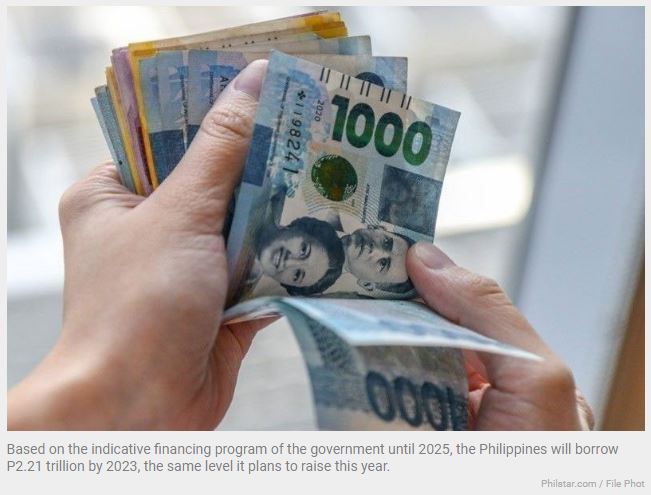Philippines: Borrowings to remain above P2 trillion level
MANILA, Philippines — The Philippines will continue its borrowing program at over P2 trillion, at least in the short term, according to the Bureau of the Treasury.
Based on the indicative financing program of the government until 2025, the Philippines will borrow P2.21 trillion by 2023, the same level it plans to raise this year.
This will increase by 9.56 percent to P2.418 trillion by 2024 and will decline by 14 percent to P2.1 trillion by 2025.
This year’s borrowing program is 13 percent lower than the 2021 level of P2.55 trillion.
The government has so far fulfilled 48.4 percent of this year’s borrowing program at P1.1 trillion, of which 69 percent originated from domestic issuances and 31 percent from various external sources.
But this remains high compared to the P1-trillion level financing program of the government prior to COVID.
During the organizational meeting of the Senate committee on ways and means on Tuesday, national treasurer Rosalia de Leon said the government plans to fulfill the remainder of its financing on an 80:20 domestic-external funding split and achieve the full-year blend of 75:25 ratio.
“Our borrowings by 2023 and 2024 will be sourced from domestic markets as part of our prudent debt management strategy and our initiatives to further develop our domestic capital markets,” De Leon said.
Even with the record national government debt at P12.79 trillion as of end-June, De Leon said “debt remains eminently sustainable and resilient to external shocks.”
The country’s debt level, when measured against the gross domestic product (GDP), is currently at 62.1 percent as of the second quarter.
The current debt-to-GDP ratio remains above the internationally accepted threshold of 60 percent, which puts the Philippines at a vulnerable spot in terms of its capacity to pay its financial obligations.
“As with many emerging market economies, we have seen a significant deterioration in our debt ratio over the past two years, with the debt already crossing the acceptable threshold of 60 percent in 2021, and remaining so for the next two years,” De Leon said.
“But our debt remains eminently sustainable and should peak at 62 percent of GDP this year, then gradually decline to 61.1 percent in 2023, 60.2 percent in 2024 and 58.5 percent in 2025,” she said.
Nonetheless, the national treasurer argued that the government’s heavy reliance on domestic financing has led to the redenomination of the country’s debt, allowing debt servicing to be less vulnerable to foreign exchange volatilities.
“Because of our conscious practice of stretching our maturity, our debt portfolio provides sufficient time to expand a revenue base in our economy before principal payments fall due the tenor composition of our debt remains mainly in the medium to long tenors,” de Leon said.
“Only 11.1 percent of our debt are variable interest rate terms, minimizing our exposure to interest rate resetting in light of the interest rate normalizations observed locally and abroad,” she said.
De Leon said the government’s ability to preserve debt below average and around the median has helped the country safeguard sovereign ratings amid the sea of downgrades after a significant rise in government public debt due to the pandemic.
Finance Secretary Benjamin Diokno assured the public that the Philippines would not suffer the same fate of Sri Lanka that continues to deal with its political and economic crisis.
“I can assure you that we won’t go the Sri Lanka way. We are very careful with our borrowings,” Diokno said, adding that “with the strengthened tax system, I think we should be able to service whatever we borrowed down the road.”
Source: https://www.philstar.com/business/2022/08/17/2203105/borrowings-remain-above-p2-trillion-level-


 English
English




